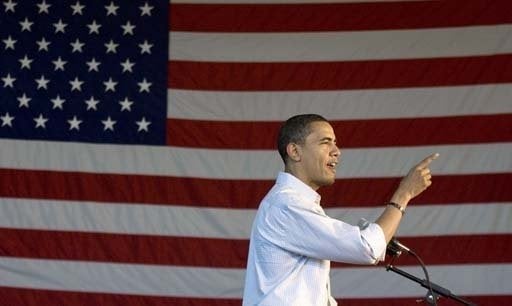
Political campaigns are, to a great extent, about numbers; and this year's presidential race has been no exception. The numbers we have heard throughout the campaign include 2025 - the number of delegates needed to secure the democratic nomination. Even this number had been disputed as the Clinton campaign has briefly tried to float the number 2209 as the real number of delegates needed to win the nomination, based on her desire to count the results in Florida and Michigan. 270 is the number of electoral votes needed to win in November. 14,000 is the number of votes by which John McCain beat Mike Huckabee in South Carolina to solidify his position as the Republican frontrunner and ease his path to the nomination.
There are, of course, many more numbers which I could cite as well, but there is one number which has been overlooked but is also very important for this election. That number, or more accurately year, is 1964. 1964 was the year the Beatles first toured the US, the year Mickey Mantle hit his last World Series homerun, the year we passed the Civil Rights Act. In 1964, John McCain had yet to be captured by the Vietcong; Hillary Rodham campaigned for Barry Goldwater; and Barack Obama was a toddler. 1964 was also the last time a Democratic nominee for President carried majority of the white working class vote, measured by either income or education. Since that time, no Democrat has carried a majority of these voters.
During the 44 years since Democrats last carried a majority of lower income white voters, this group has been called the silent majority, Reagan Democrats, angry white men and various other labels, but they have proven to be a relatively dependable part of the Republican coalition, providing significant majorities for GOP candidates Richard Nixon, Gerald Ford, Ronald Reagan, George H.W. Bush, and George W. Bush.
Obviously, losing this block of voters once central to the Democrat coalition was not easy for the party. However, 1964 was a long time ago and the party needs to move on and develop a strategy that recognizes this political reality. When, in the recent primary season, Hillary Clinton reinvented herself as the representative of the white working class voters, her surrogates and operatives dutifully reminded the media that the white working class is a key part of the Democratic base. Her campaign team was not simply spinning. They were saying what many Democratic strategists and leaders believe to be true, even in the face of 44 years of evidence to the contrary.
Clearly a Democratic nominee for president needs to win some chunk of the white blue collar vote, but winning a majority of that vote is not a realistic goal. Understanding this is essential because decisions about resource allocation are critical in campaigns. Strategic decisions to prioritize this vote over other segments of the electorate which might be easier to win could be very costly in November. By trying to win blue collar voters in the rust belt, Democrats overlook other potential growth areas for their party such as the west and, increasingly the south.
There are now several states in the west such as Wyoming and Montana where Democrats have recently won statewide elections, as well as southern states where Democrats are becoming competitive again. This strength has occurred largely without relying on blue collar white voters. Western voters have come to the Democratic Party out of concern about Bush's foreign policy and the growing sense that the Republican Party is no longer a good fit for their libertarian leaning view of politics. In the South, growing numbers of knowledge workers and other white liberals have, along with African American voters, formed the backbone of the Democratic coalition which has elected senators and governors throughout the region in recent years. In both regions, the increase in Latino voters has helped the Democratic Party as well.
Accepting this different road to 270 electoral votes will be difficult for many in the Democratic Party who have spent decades searching for the silver bullet that would bring white blue collar workers home to the Democrats. Unwillingness to accept this was at the heart of Hillary Clinton's electability narrative. Her narrative, that she was uniquely positioned to bring Reagan Democrats back home in November was prima facie absurd, but got an enormous amount of traction and was largely unchallenged in the media or, frankly, by the Obama campaign. The reality was that Clinton remained unpopular with this group, with 55% of white voters who had not completed college viewing her unfavorably in an April, 2008 AP poll.
The broader notion, however, that the only way for the Democrats to win was by sweeping the rust belt, is so widely accepted that Clinton's argument went unquestioned. The question that should be asked is that given that in each of the last two presidential elections the Democrats tried this strategy and failed, why would Clinton's chances in 2008 be any different. In 2004 the Democrats ran a war hero, albeit a liberal and extremely wealthy one from the Northeast, against an unpopular president who was viewed as mishandling an unpopular war, and still managed to lose Ohio, and, of course, the election. Betting the farm on the notion that in 2008 the Democrats can carry Ohio and win the election by running very liberal and very wealthy senator from the Northeast with no war record against a Republican who is a war hero and who has been critical of the mismanagement of an unpopular war, seems to fit at least one definition of insanity-doing the same thing over and over and expecting different results.
For the Democrats to win, they need to look to the future, not the past. The future has implicitly been one of the themes of Barack Obama's campaign. This is one of the reasons he has done so well with young voters and secured the nomination of the Democratic Party. More importantly, the path to victory for Obama is a 21st century one where Democratic strength in the northeast, upper midwest and the west coast is the base, as it has been in recent years, but the margin of victory will come from winning a few southern and western states. Obama is far more popular than Clinton in these regions and has swept primaries and caucuses in these states. Ohio and Pennsylvania aren't the only states with electoral votes that can get the Democrats to 270. North Carolina has 15, Virginia 13, Montana 3, Colorado 9 and New Mexico 5. These are also numbers worth watching in 2008.
